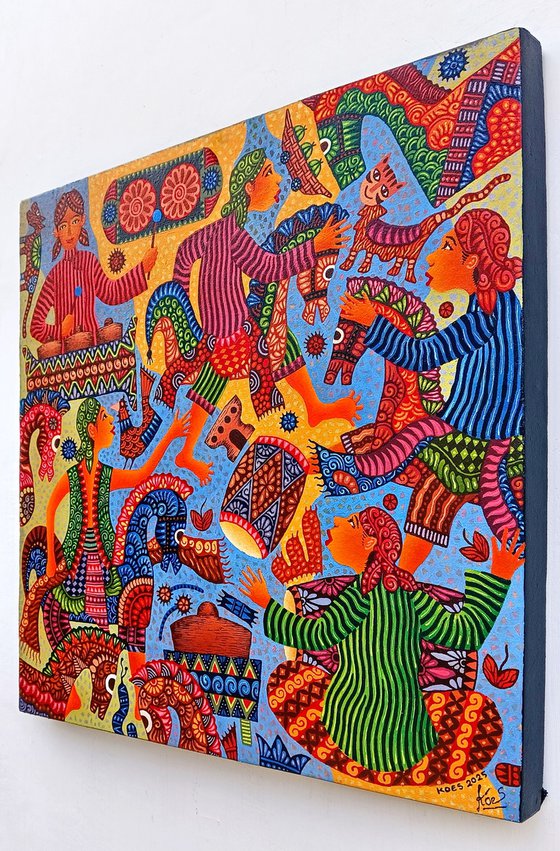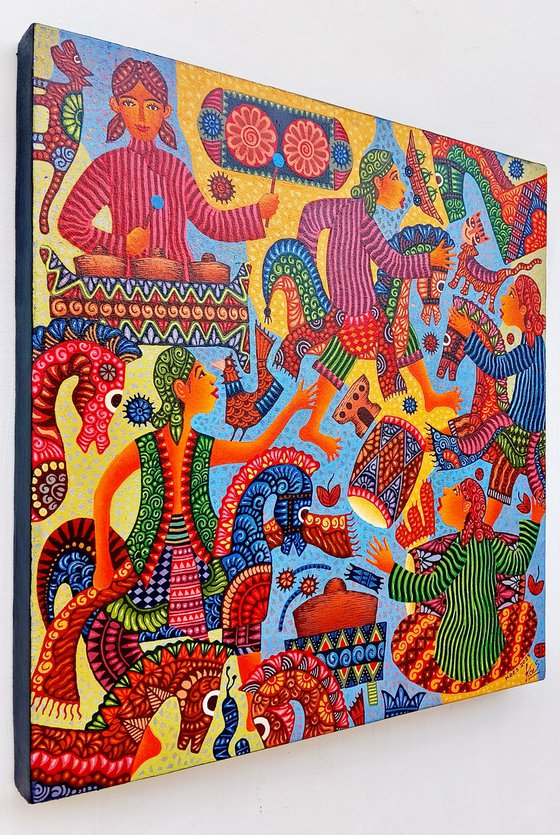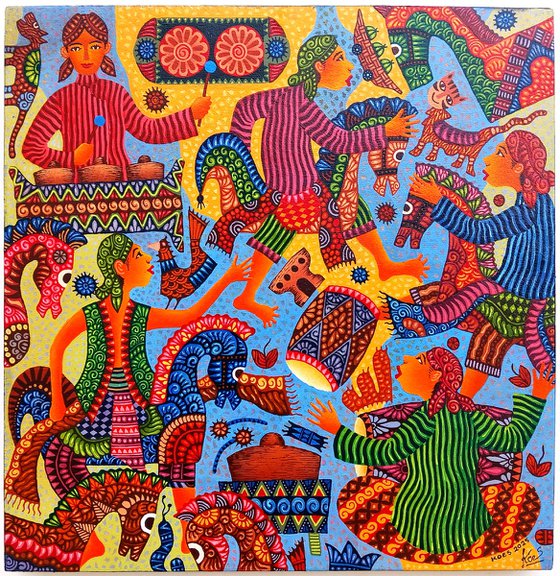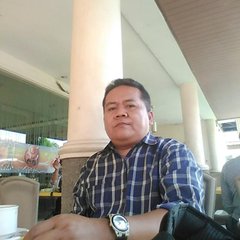- By medium
- By subject
- By budget
- Sales
- Gift cards
- Discover all art
- Artists
- Editors’ picks
- Ideas
Original artwork description:
History of the Kuda Lumping Dance
The Kuda Lumping dance is a traditional performing art originating from the island of Java, Indonesia. This dance is known by various names in different regions, such as Jaran Kepang, Jathilan, or Kuda Kepang. The performance involves dancers riding replica horses made of woven bamboo or leather, often accompanied by magical and mystical elements.
Origins of the Kuda Lumping Dance
The origins of the Kuda Lumping dance do not have a single definitive historical source. However, there are several theories regarding its emergence:
1. Warrior Struggle Theory: Some historians believe that this dance dates back to the era of Javanese kingdoms such as Majapahit and Mataram. It is thought to depict the spirit and bravery of cavalry soldiers in battle.
2. Religious Ritual Theory: Another theory suggests that Kuda Lumping was initially part of religious or customary rituals, serving as a tribute to ancestral spirits or a form of prayer for the safety and well-being of the community.
3. Folk Entertainment Theory: Over time, this dance evolved into a form of folk entertainment performed at various events such as celebrations, ceremonies, and cultural festivals.
Characteristics and Mystical Elements
The Kuda Lumping dance has several distinctive features that set it apart from other traditional dances:
• Replica Horse Props: Dancers use woven bamboo horses, symbolizing real horses.
• Energetic Movements: The dance is performed with dynamic, agile, and spirited movements.
• Musical Accompaniment: Traditional musical instruments such as gamelan, kendang (drums), and gongs create a unique atmosphere in the performance.
• Mystical Elements: In some performances, a trance session occurs where dancers enter a state of possession and display supernatural abilities, such as eating glass or walking on hot embers. This is believed to be a form of interaction with spiritual forces protecting the performance.
Development and Modernization
Today, the Kuda Lumping dance is still preserved in various regions of Indonesia, especially in Central Java, East Java, and Yogyakarta. Although its mystical elements have diminished in some modern performances, the cultural and aesthetic values of the dance remain upheld. In fact, Kuda Lumping has undergone innovations, making performances safer and more accessible to the public without involving supernatural elements.
Conclusion
The Kuda Lumping dance is a cultural heritage rich in historical, spiritual, and entertainment value. Its continued existence demonstrates the strength of traditions and artistic values passed down through generations. By preserving and adapting it to modern times, Kuda Lumping remains one of Indonesia’s iconic performing arts that captivates audiences worldwide.
Materials used:
acrylik on canvas
Tags:
#funny #traditional dance #color (tinted) #traditional patern #traditinal artTARIAN KUDA LUMPING (2025) Acrylic painting
by Kus Budiyanto
£982.35
- Acrylic painting on Canvas
- One of a kind artwork
- Size: 65 x 65 x 4cm (unframed) / 65 x 65cm (actual image size)
- Ready to hang
- Signed on the front
- Style: Illustrative
- Subject: People and portraits
Loading
Original artwork description
History of the Kuda Lumping Dance
The Kuda Lumping dance is a traditional performing art originating from the island of Java, Indonesia. This dance is known by various names in different regions, such as Jaran Kepang, Jathilan, or Kuda Kepang. The performance involves dancers riding replica horses made of woven bamboo or leather, often accompanied by magical and mystical elements.
Origins of the Kuda Lumping Dance
The origins of the Kuda Lumping dance do not have a single definitive historical source. However, there are several theories regarding its emergence:
1. Warrior Struggle Theory: Some historians believe that this dance dates back to the era of Javanese kingdoms such as Majapahit and Mataram. It is thought to depict the spirit and bravery of cavalry soldiers in battle.
2. Religious Ritual Theory: Another theory suggests that Kuda Lumping was initially part of religious or customary rituals, serving as a tribute to ancestral spirits or a form of prayer for the safety and well-being of the community.
3. Folk Entertainment Theory: Over time, this dance evolved into a form of folk entertainment performed at various events such as celebrations, ceremonies, and cultural festivals.
Characteristics and Mystical Elements
The Kuda Lumping dance has several distinctive features that set it apart from other traditional dances:
• Replica Horse Props: Dancers use woven bamboo horses, symbolizing real horses.
• Energetic Movements: The dance is performed with dynamic, agile, and spirited movements.
• Musical Accompaniment: Traditional musical instruments such as gamelan, kendang (drums), and gongs create a unique atmosphere in the performance.
• Mystical Elements: In some performances, a trance session occurs where dancers enter a state of possession and display supernatural abilities, such as eating glass or walking on hot embers. This is believed to be a form of interaction with spiritual forces protecting the performance.
Development and Modernization
Today, the Kuda Lumping dance is still preserved in various regions of Indonesia, especially in Central Java, East Java, and Yogyakarta. Although its mystical elements have diminished in some modern performances, the cultural and aesthetic values of the dance remain upheld. In fact, Kuda Lumping has undergone innovations, making performances safer and more accessible to the public without involving supernatural elements.
Conclusion
The Kuda Lumping dance is a cultural heritage rich in historical, spiritual, and entertainment value. Its continued existence demonstrates the strength of traditions and artistic values passed down through generations. By preserving and adapting it to modern times, Kuda Lumping remains one of Indonesia’s iconic performing arts that captivates audiences worldwide.
Materials used:
acrylik on canvas
Tags:
#funny #traditional dance #color (tinted) #traditional patern #traditinal art14 day money back guaranteeLearn more



